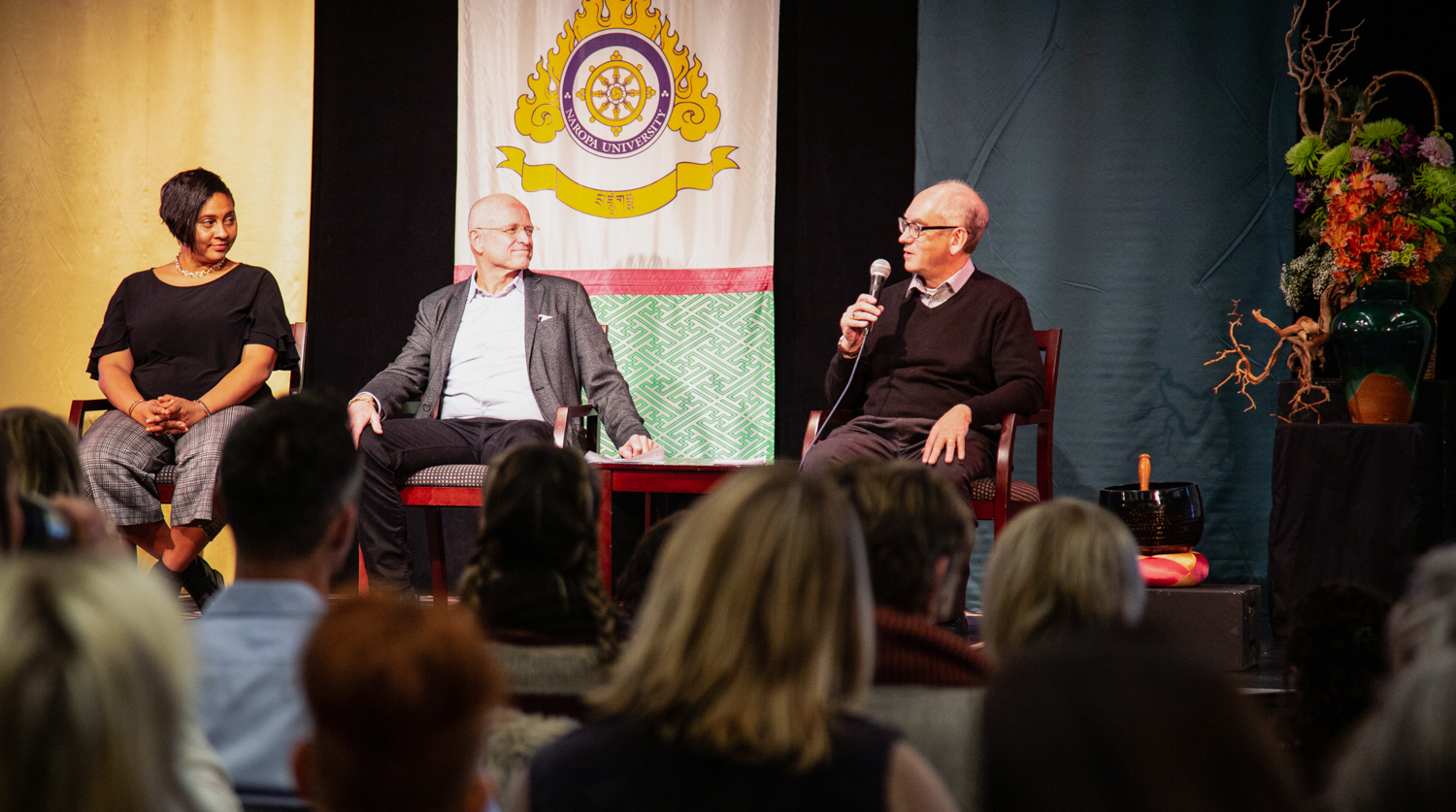Taking Refuge in the Triple Gem
The three jewels make up the lineage, philosophy, and community of Buddhism, explains Christina Feldman, and their purpose is to deepen and expand our practice. The post Taking Refuge in the Triple Gem appeared first on Lions Roar.

Essentially each practitioner of Buddhist meditation makes the journey alone, but many find that committing themselves to the three jewels — Buddha, dharma, and sangha — helps take them further. These three make up the lineage, philosophy, and community of Buddhism, explains Christina Feldman, and their purpose is to deepen and expand our practice.

Photo by Pavlo Semeniuk.
When we embark on the meditative journey, we may enter through many different gateways. We may begin to practice meditation as a way of finding a little more calm in the midst of a chaotic life, to find respite from our turbulent mind. We may begin to meditate to find a way to meet adversities with greater understanding and balance. We may be drawn to meditation through experiences of joy—glimpses of stillness, intimacy, and connectedness—that inspire us to question whether such moments could be more than just accidental encounters. Both sorrow and joy can bring us to a point where we acknowledge the urgency of finding ways to be more at peace with ourselves, to be kinder, and to be more present in all the moments of our life.
Taking refuge in the three jewels is an inner journey, coming home to what is true.
Practicing with sincerity, persevering through the peaks and valleys that are part of every spiritual path, we begin to discover that practice does indeed bear fruit. A steady mind begins to be more accessible, we are less prone to be reactive or judgmental, and greater sensitivity and mindfulness allow us to feel more connected to the present moment and to our surroundings. Our capacity to be delighted by life’s beauty is awakened, as is our ability to meet hardship without being overwhelmed.
But this is not the end of the journey. Rather, the journey has now truly begun.
As our practice deepens, our eyes open to possibilities beyond composure and balance. We open up to the possibility of an unshakeable liberation, a timeless wisdom, and being intimately part of a wider community of people who treasure compassion and integrity. We may be inspired to bind ourselves more deeply to the path and to those around us.
At this point, we may begin to ask ourselves not only what meditation practice is but what it means to live a meditative life. To help us accomplish this, we look beyond our personal practice and seek the support of what are known in Buddhism as the three jewels. These are the Buddha, or other living embodiment of enlightenment; the dharma, the philosophy and teachings of Buddhism; and the sangha, the community of realized beings and of our fellow practitioners. As so many others have before us, we may decide to take refuge in the three jewels as a way of continuing to open to the deeper possibilities we have glimpsed. This is an important step on the journey and one we will repeat many times over. So what does it mean to take refuge and what do the three jewels really mean?
Taking Refuge
I take refuge in the Buddha
I take refuge in the dharma
I take refuge in the sangha
In monasteries around the world these three lines are chanted daily, and many meditation retreats here in the West begin with a recitation of this formula. We might see these as quasi-religious sentiments or statements of belief that seem irrelevant to our own life and spiritual practice. But the great power of taking refuge is that it opens our eyes to the whole of the teaching, not just the parts we find convenient. Taking refuge can also help us find the capacity to meet hardship compassionately—and with steadiness—rather than with flight and denial. But before that can happen, we need to come to understand what we commit to when we make these statements. Taking refuge in the three jewels (also known as the triple gem or the three treasures) is a commitment born of reflection and investigation.
“Taking refuge,” a good translation of the original Pali, literally refers to the act of returning to a place of sanctuary or shelter to find safety, peace, and protection: a child finds refuge in the arms of a loving parent; we find shelter from a storm beneath the branches of a tree; we return home to a caring relationship for sanctuary and peace.
Taking refuge in the three jewels is an inner journey, coming home to what is true. It is a profound act of devotion and inner commitment to a clear mind, an open heart, and a way of engaging with life that is pervaded with integrity, respect, and compassion. If our commitment is profound, we give ourselves unreservedly to a life of wakefulness, to bringing all that is truthful and healing into every aspect of our life. If our devotion is wholehearted, we align our thoughts, words, and acts with the teachings that lead to liberation.
Taking refuge in the Buddha, we commit ourselves to our own capacity for freedom. Taking refuge in the dharma, we bring the path of awakening to life. Taking refuge in the sangha, we acknowledge our interconnectedness.
The Buddha
The Buddha is the personification of an awakened being, a person who knows unshakeable inner freedom, peace, and compassion. In this context, the Buddha represents not only the historical Siddhartha we are familiar with, but also all the great teachers throughout time who embody a depth of wisdom and compassion that changes the world around them. The Buddha is a symbol of the third noble truth (cessation)—that it is truly possible to know the end of anguish and struggle, to discover a heart that is liberated from confusion and pain.
The Buddha also points to the potential for awakening that lives in each of us. The Buddha encourages us to discover for ourselves the same freedom that buddhas throughout time have found. The Buddha is a symbol of possibility—encouraging us not to despair but to dive deeply into our hearts to find the wisdom that can heal and liberate us.
When we think of the Buddha, our immediate association may be with the statue seated on a lotus flower that lives on an altar, in a museum, or in our garden. We can be inspired by the stories of the Buddha, yet still feel minimal relationship with this historical figure. The path and practice invite us to bring the Buddha out of abstraction and into reality, to bring the Buddha to life. Many of us have glimpsed the Buddha in others and ourselves. It is our buddhanature that inspires us to reach out a hand to comfort and support a friend in need, to forgive someone who has harmed us, and to say no to injustice. It is our buddhanature that grieves at the pain in the world and rejoices at happiness and love. Our buddhanature brings us back to the cushion when we face difficulty and pain, trusting that we can find the understanding and steadfastness to meet our life.
When our eyes and hearts are open, we glimpse buddhanature shining in countless moments. My first teacher lived in a simple mud hut, never knowing where his next meal would come from, yet he welcomed us unruly Westerners with a beaming smile and a limitless willingness to offer the teaching of wisdom and compassion. I have friends who are raising a severely disabled child with boundless patience and love; for them it is a spiritual journey. My own heart is touched on a daily basis not only by the great people of this world who have dedicated themselves to justice, peace, and compassion, but also by the many acts of generosity offered by strangers. Our practice of awareness opens our eyes to the many acts of peace, kindness, and compassion we encounter in our daily lives.
In addition to serving as an example of the buddhanature that lies within all of us, the Buddha was a teacher, a healer, and a guide showing the way to peace. He empowered students to discover the same liberation within themselves that he found. He wanted graduates. He showed the way to the end of suffering. The teachers I have been privileged to practice with in my own life have offered the same generosity. As Westerners we are prone to be either in awe of or mistrustful of authority. The Buddha discouraged blind faith in teachers, but also honored their place in the journey of discovery and transformation. To find a teacher who will not only console us in times of difficulty but will also challenge our delusion is a great blessing. We sense their buddhanature in the fact that they want nothing from us. They want neither honor, flattery, nor allegiance. They only want us to find our own buddhanature.
Inviting the Buddha into our heart is, in the deepest sense, to also invite the dharma and the sangha into our life. It means taking upon ourselves the willingness and responsibility to embody our buddhanature.
The Dharma
The dharma is the path that leads to the realization of our buddhanature. It teaches us the universal story of change, unsatisfactoriness, and nonself that runs through all of our lives. It reveals our interconnectedness, which is usually clouded by delusion and fear.
The dharma is what we practice when we sit down with the intention to let go, to calm the waves of agitation in our hearts, and to understand what is true. When we go out into our day with the commitment to not harm and to protect the well-being of all living beings, we are practicing the dharma. When we are generous with our time, attention, and love, we embody the dharma. When we resolve to be truthful, to treasure a clear mind, and to engage the world with respect and appreciation, we live the dharma.
The teachings of profound wisdom found in the volumes of scriptures are intended not only to be absorbed only as an intellectual exercise but also to be assimilated and embodied. All of us are asked to take the teachings off the bookshelves and into every dimension of our lives, leaving nothing untouched. We come to know the wisdom of a buddha when the dharma is our life and our life is the dharma. Making life into dharma is an ongoing practice, which is why it is called a path.
The dharma is our heart’s commitment to all that is healing and liberating. It is not a commitment we make just once. Rather, we make it countless times in a single day. It is a commitment not to an ideology or belief system—to the volumes of scriptures—but to our own buddhanature. It is only when we begin to wake up and be more mindful and present in our life that we realize how remarkably forgetful we can be. We begin to appreciate how easy it is to be lost in habits of aversion, resistance, greed, and heedlessness. Every time we can find the willingness to be with what is and step out of the cycles of resistance and forgetfulness, we renew our commitment to the dharma. Each time we choose a path of kindness rather than aversion, seek peace rather than conflict, speak with truthfulness rather than dissemble, we are practicing the dharma.
All these small moments of commitment, where we renew our intention to be awake in our life, do bear fruit. Our hearts and lives are changed by the daily commitments we make to act in accord with dharma. In the beginning, trying to live with integrity, clarity, and compassion feels effortful, almost heroic, at times even impossible. But with practice, it becomes less of a concerted effort. It feels quite possible and natural to live according to dharma. We live in greater peace and openness, we fall in love with awareness, and our mind becomes our friend.
The Sangha
The sangha, or the community of the wise, can be understood on at least three levels. One is called the noble sangha, the community of those who are awakened and embody that wisdom. These are the buddhas and teachers who inspire and encourage us. They are the people who have touched us with their unwavering commitment to end the suffering and anguish in our world. We aspire to follow their example.
The sangha is also the monastic order of monks and nuns, people who inspire us with the simplicity and integrity of their lives. In a recent meeting of Buddhist teachers, when many people were reporting on the projects and ventures their centers were undertaking, one of the ordained sangha reported that the monks and nuns really didn’t do very much. On one level that is quite true. They have no mission to build and support centers, create programs, or fundraise. On another level it is by “not doing very much” that the ordained community does so much, reminding us by their presence how deeply important it is to dedicate our hearts and lives to ethics, mindfulness, and liberation. They are a living presence of simplicity, renunciation, and commitment.
For many centuries, the long lineage of the monastic sangha has offered refuge to those who have no refuge, brought life to the dharma, and reminded us of the most precious gem of all, the treasure of liberation. Monasteries in Asia are home to those who have left the world but who are also endlessly available to the world. They support children who are orphaned and the elderly who have no family. They educate and speak out for social justice and bear witness to the births and deaths of the laypeople in their communities. The monastic community in a very real way endeavors to be a microcosmic view of a just and compassionate society, rooted in ethics, respect, and wise relationship.
Finally, the sangha is found in the communities and relationships of trust and integrity we nurture in our own lives. Genuine sangha is any relationship that treasures harmony and practices the wisdom of interconnectedness. It is challenging to go on silent retreats and to cultivate a practice where we sit with ourselves on a cushion. But in our individualistic culture, it is far more challenging for many people to cultivate community and true friendship. Each one of us gets up off our meditation cushion and enters into the world of relationship. Bringing our practice and our commitment to wakefulness into that world is what enriches our practice and gives it meaning. Our path remains incomplete as long as this third treasure is omitted.
It is in community that we discover how hard it is to live in a truly ethical way. A friend of mine said that if practicing the Buddhist precepts, the guidelines for how to conduct ourselves with attention and kindness, “does not make your life more uncomfortable, you haven’t understood them well.” It is in community that our commitment to kindness and openness is challenged, that we begin to understand that generosity and forgiveness require letting go. Nowhere else in our lives are we so vulnerable as in our relationships, so the Buddha’s teaching encourages us to cultivate a wise vulnerability. To learn how to speak truthfully, to listen without defensiveness, to learn how to offer and receive kindness, to let go of our personal story and listen deeply to our universal story, are all lessons of wise community.
As our practice deepens, we increasingly understand the truth of our interconnectedness and interdependence. All beings long for happiness, to be understood, and to be protected. All beings long to be free from pain, struggle, and fear. In a very real way, both my happiness and sorrow are linked to yours. We cannot seek our own awakening; we can only take part in the awakening of all beings.
The cultivation of community, or sangha, is ultimately to commit ourselves to respectful and appreciative relationships. It is a commitment to discovering the buddhanature in all beings and to embodying our dharma, our own understanding. It is not always possible for us to connect with and be part of established dharma communities, yet it is always possible for us to nurture community within the relationships already present in our lives. We can all learn what it means to be a true friend to another, offering kindness, honesty, and understanding. Making time for friendship to develop—persevering with the challenges that relationship inevitably brings—respects the value that community plays on our path.
The triple gem is three parts that are completely interwoven. They hold within them the whole of the teaching and path of liberation. We call Buddha, dharma, and sangha the three jewels or treasures because they have profound and enduring value. Nurtured together, they lead to unshakeable liberation.

 JaneWalter
JaneWalter 































